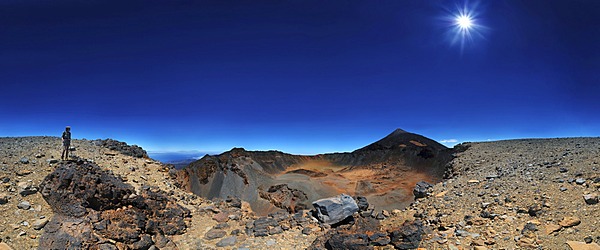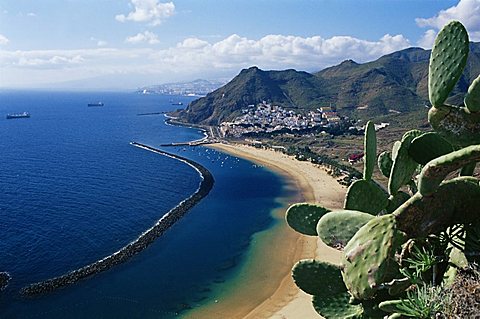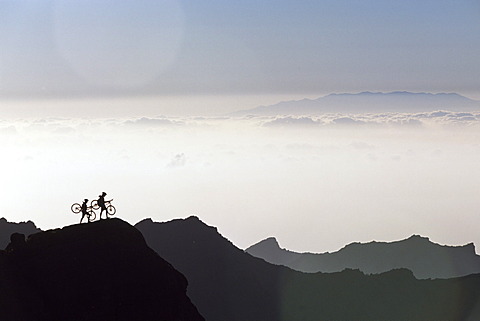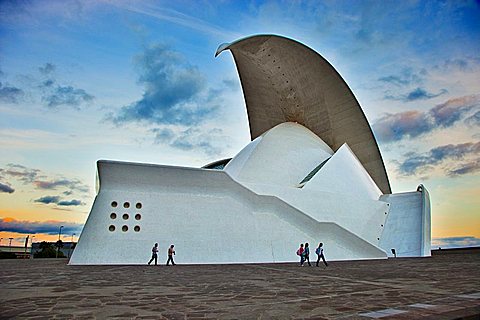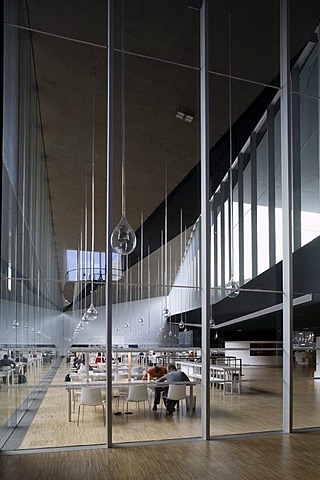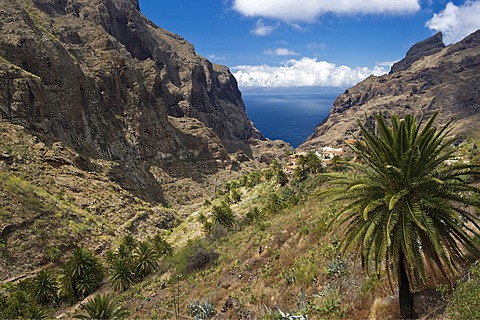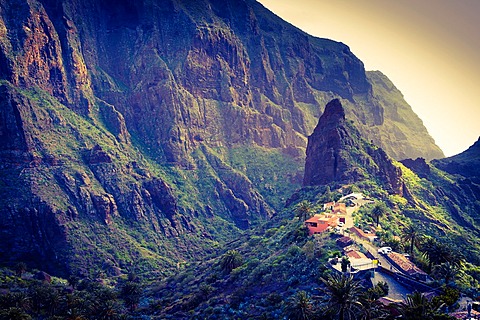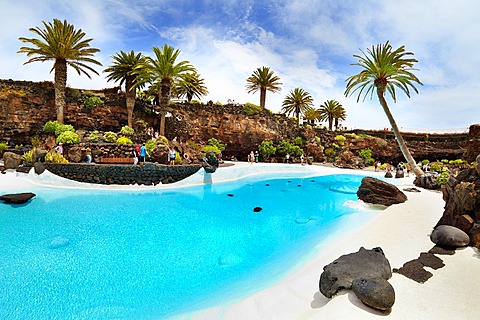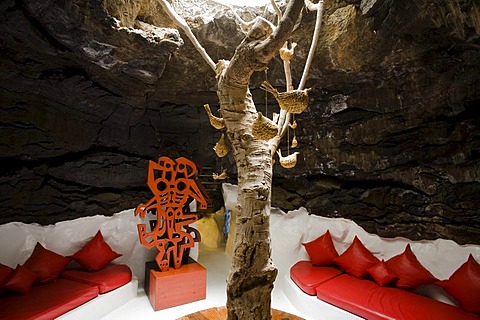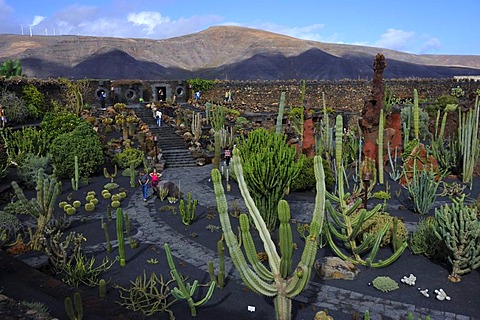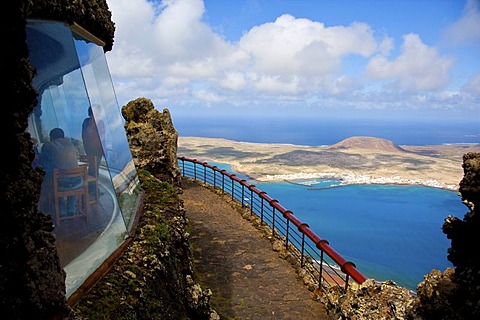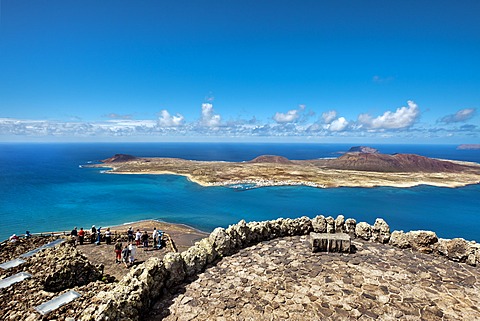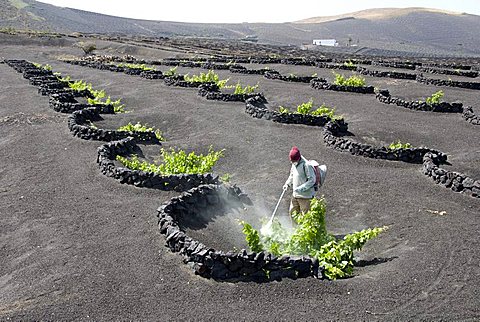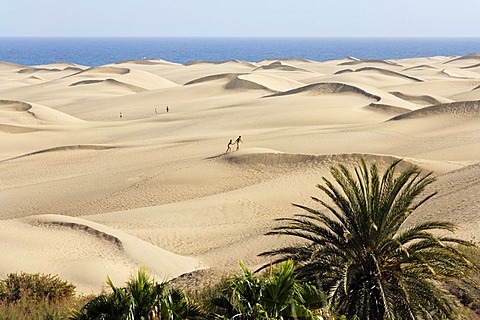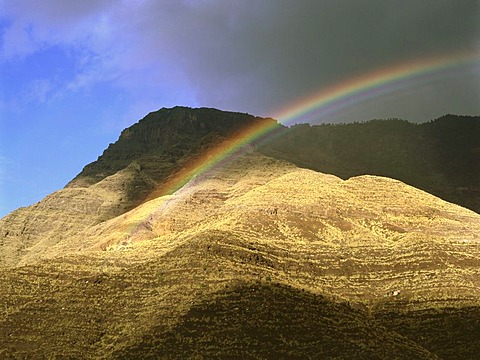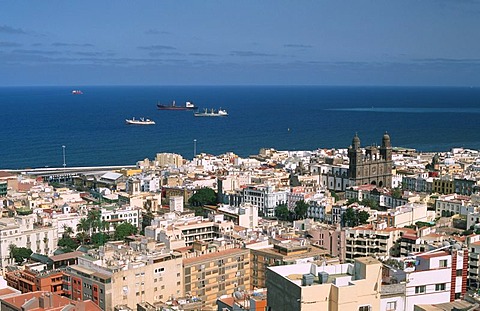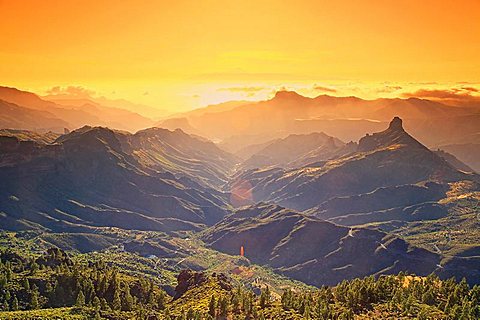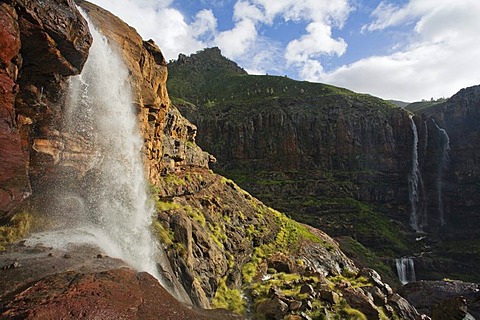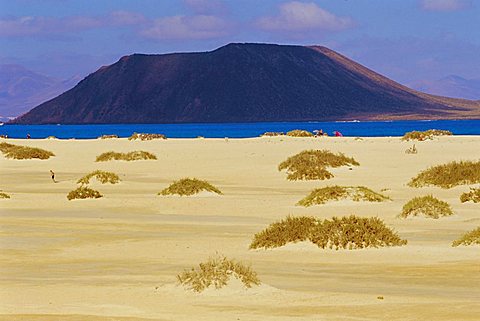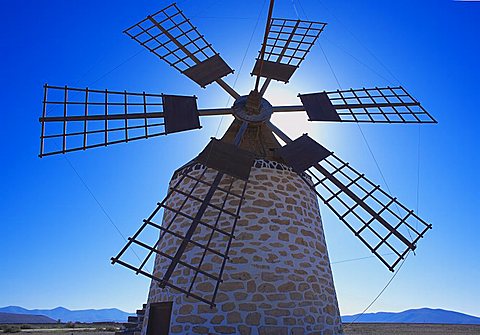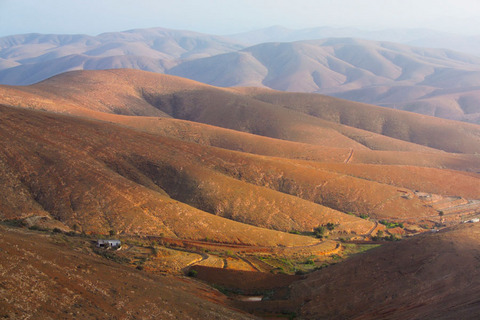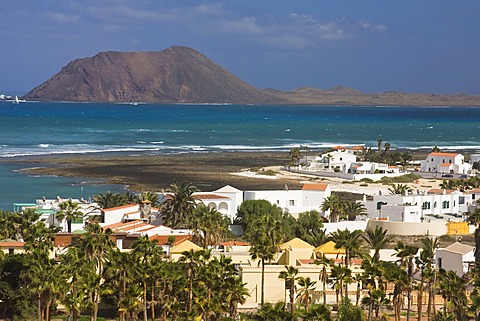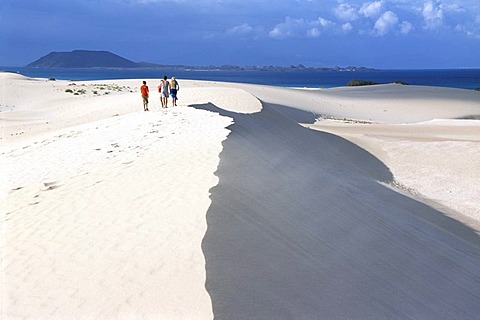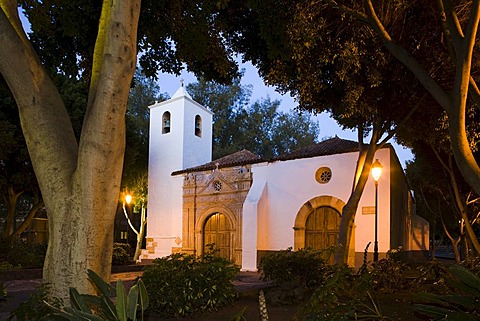As the frosts kick in in the Northern Hemisphere, the Canary Islands bask in temperatures that vary little from their summer highs – making their stunning coastlines and dramatic landscapes appealing year-round. This Spanish archipelago off the northwest coast of Africa consists of seven main inhabited islands, out of which Tenerife, Gran Canaria, Fuerteventura and Lanzarote are the easiest to get to. Although best known for their amazing beaches like black sand Bollullo on Tenerife, epic Papagayo on Lanzarote and the dunes of Gran Canaria’s Maspalomas, venture off the beaten track and you’ll find otherworldly volcanic landscapes, hidden beaches and lively towns peppered with cutting edge architecture.
360 degree panorama of the Pico Viejo volcano and Pico del Teide mountain with a woman standing at the edge of a crater, Teide National Park, Tenerife (Robert Harding/Michael Rucker)
Tenerife
Tenerife’s vibrant and accessible capital, Santa Cruz, makes a great base since most of the best sites on the island are accessible from here, including beaches like black sand gem Bollullo and the golden curved bay of Las Teresitas.
The town itself has unexpected attractions including beautiful plazas, lively nightlife, and world-class contemporary architecture. The city’s newest draw, the Tenerife Espacio de las Artes (or TEA), is a futuristic wonder designed by the creators of Tate Modern, made of glass and the island’s famed black volcanic rock. Another modern must see is the spectacular curved Auditorium, home to the Santa Cruz Symphony Orchestra.
For fitness fanatics and those who want to slough off the office lifestyle, Tenerife offers walking and cycling terrain that’s perfect for activity based holidays. Climb or mountain bike the 3,718 metre peak of mount Teide, whose National Park setting draws rock climbers from all over the world, or take the gorgeous three hour trek from Masca down to Masca Bay.
Aerial view of Playa de las Teresitas and Santa Cruz de Tenerife, Tenerife (Robert Harding/Marco Simoni)
Mountain biking in Masca, Tenerife (Robert Harding/Norbert Eisele-Hein)
Teide Mountain, Tenerife (Robert Harding/Oliver Gerhard)
People wearing traditional dress and singing during Corpus Christi celebration, La Orotava, Tenerife (Marco Simoni/Robert Harding)
Opera House Santa Cruz de Tenerife Tenerife (age fotostock/Robert Harding):
Interior view of the public libary at the Tenerife Espacio de las Artes, Santa Cruz de Tenerife (Robert Harding/Juergen Richter)
Mountain village of Masca in the Teno mountains, Tenerife (Robert Harding/Daniel Schoenen)
Masca, Teno Rural Park, Tenerife (Robert Harding/Mikel Bilbao)
Lanzarote
Thanks to artist and architect César Manrique the island he loved – with its cactus-strewn panoramas of black lava, emerald vines and flame red peaks – retains its fascinating landmarks and volcanic wonder, outside of the crowded resorts.
Saving the island from the onslaught of high-rises and keeping its architecture true to tradition through his influence on planning in the 60s onwards, Manrique also designed concert halls, swimming pools and restaurants incorporating bubbles of volcanic rock and streams of solid black lava.
Stay in one of the island’s stylish eco-friendly hideaways, boutique hotels or even luxury yurts and walk or cycle to Manrique’s Mirador del Río overlooking the neighbouring island of Graciosa, take a camel ride through the Martian volcanic landscapes of Timanfaya National Park and sample local wines in the subterranean restaurant and lake of Jameos del Agua. The Cesar Manrique Foundation, set in the artist’s former house in the village of Tahiche is a good place to start exploring his legacy.
Timanfaya National Park, camel excursion to visit the volcano, Lanzarote (Tuul/Robert Harding)
Lanzarote, Jameos del Agua, volcanic cave founded by artist Cesar Manrique (Robert Harding/Jan Wlodarczyk)
Former residence of artist and architect Cesar Manrique, Fundacion Cesar Manrique, Taro de Tahiche, Lanzarote (Robert Harding/Juergen Richter)
Cactus garden ‘Jardin de Cactus’, Fundacion Cesar Manrique, Tahiche, Lanzarote (Robert Harding/R. Kiedrowski)
Mirador del Rio by Cesar Manrique in Lanzarote (Robert Harding/Carlos Sanchez)
View from the restaurant and viewpoint, Mirador del Rio, by architect Cesar Manrique, Lanzarote (Robert Harding/Sabine Lubenow)
Vineyards of La Geria on volcanic ash of 1730s eruptions, Lanzarote (Tony Waltham/Robert Harding)
Gran Canaria
This round island, the third largest in the Canaries, is home to nearly half its population, and its diverse terrain ranges from lush greenery in the North to arid desert in the South via the dramatic mountains of the interior, that provide an unspoiled escape from the South’s crowded resorts.
The endless dunes of Maspalomas, said to have been formed by a Tsunami, are a must see. But if the resort-based South Coast or rugged North coast beaches are too crowded for your taste, try the more desolate West, including the solitary Güigüi, a bay that is only accessible via boat or on foot.
Hiking opportunities abound in the green Parque Natural de Tamadaba and the pine forests and cacti of southerly Parque Natural de Pilancones, or if you’re more of a history lover, get a bird’s eye view of the cosmopolitan capital of Las Palmas by climbing the tower of its impressive cathedral that took around 400 years to build.
Sand dunes of Maspalomas, Gran Canaria (Robert Harding/Siepmann)
Rainbow at Faneque Mountain, Valley of El Risco de Agaete, Tamadaba Natural Park, Gran Canaria (Robert Harding/Juergen Richter)
View of the Cathedral at the Plaza Santa Ana, Las Palmas, Gran Canaria (Robert Harding/Hans Zaglitsch)
Dunes of Maspalomas and beach, Playa del Inglés resort, Gran Canaria (Robert Harding/Juergen Richter)
Central Mountains, View of West Gran Canaria from Roque Nublo (age fotostock/Robert Harding)
Waterfall Cascada El Palmar in the sunlight, Cascada El Escobar in the background, Valley of El Risco, Parque Natural de Tamadaba, Gran Canaria (Robert Harding/Juergen Richter)
Fuerteventura
Fuerteventura has a stark beauty and some of the best beaches of the Canary Islands. Despite being popular with the British, the resort of Corralejo offers relatively unspoilt expanses of white sands that give way to the desert-like dunes of the Corralejo Nature Reserve – a favourite with kite surfers. In general the east coast offers sheltered swimming opportunities, while the windy west coast is more suited to surfers.
Beyond the beaches, the parched interior is home to charming towns like the whitewashed former capital of Betancuria, and Pajara, with a rustic church decorated in an Aztec style. Elsewhere, traditional windmills built of timber and stone populate the stunning panoramas featuring long dead volcanoes and dramatic lava fields in burnt ochre colours.
The super fit can explore the highlands’ steep slopes on foot or by bike, while others may want to hire a car, taking advantage of well maintained roads to immerse themselves in this barren and immense landscape.
Sandy dunes with ‘Isla de los Lobos’ in the background, Corralejos, Fuerteventura (Marco Simoni/Robert Harding)
Old windmill, Tefia, Fuerteventura (Marco Simoni/Robert Harding)
View from Morro de la Cruz north of Betancuria, Fuerteventura (Robert Harding/Alan Copson)
Corralejo, Fuerteventura (Robert Harding/A. Rose)
Corralejo, El Jable, Fuerteventura (Robert Harding/Norbert Eisele-Hein)
Surfers at Playa del Castillo in El Cotillo (Robert Harding/R. Wittek)
The church Iglesia de Virgen de La Regla in the evening, Pajara, Fuerteventura (Robert Harding/Juergen Richter)
See more photos from the Canary Islands here


